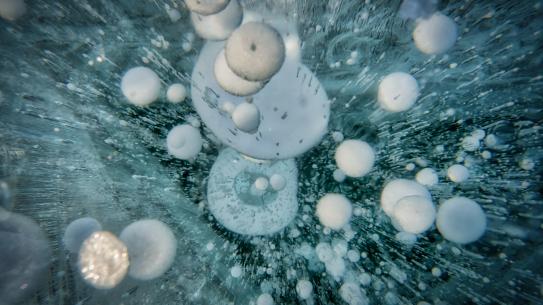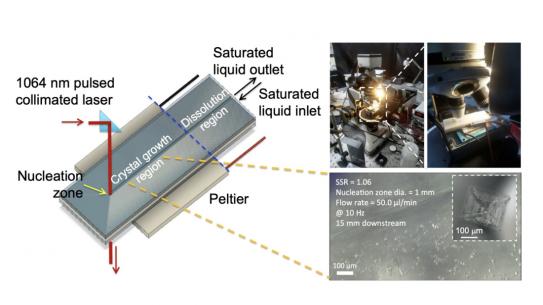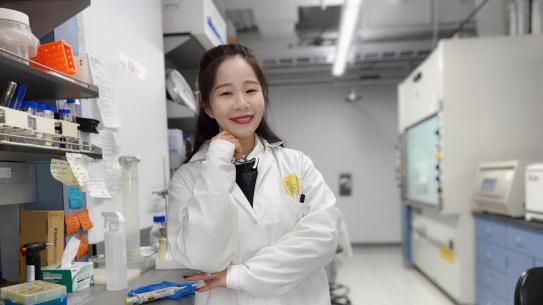Ryan Hartman
-
Full Professor
-
Chairman, NYU Tenured/Tenure-Track Faculty Senators Council

The Hartman Research Laboratory investigates impactful problems related to sustainability through application of chemical reaction engineering principles. There is a need for autonomous laboratory-scale flow reactors that can high-throughput screen and generate sufficient experimental data to decipher reaction kinetics and mechanisms. Integration of in-situ spectroscopic methods with microfluidics and their automation creates the possibility of computers working synchronously with a handful of key experiments. Thus, the design of artificial intelligence and machine learning methods with continuous-flow microreactors for faster discovery has become a central theme in most of our research. Rethinking how we perform laboratory experiments can reduce the chemical waste, energy requirements, make experiments safer, and it can yield molecular-scale information needed for predictive models for applications in chemicals, energy, healthcare, and materials towards a sustainable future.
Ryan L. Hartman is Full Professor in the Department of Chemical and Biomolecular Engineering in the NYU Tandon School of Engineering. Prof. Hartman completed his postdoctoral research in the Department of Chemical Engineering at the Massachusetts Institute of Technology (Cambridge), his Ph.D. in Chemical Engineering from the University of Michigan (Ann Arbor), and his B.S. in Chemical Engineering from Michigan Technological University (Houghton). He is also a Senator for NYU Tandon, serves on the Faculty Executive Committee of his School, the currently elected Chair of NYU's Tenured/Tenure-Track Faculty Senators Council representing NYU's T/TT faculty, and he is a Member of the NYU Senate Executive Committee. He has also filled various executive leadership roles for the American Institute of Chemical Engineers (AIChE), the Past President and Current Member of the Executive Board of Directors of the International Symposia on Chemical Reaction Engineering (ISCRE), and a Member of the Advisory Board of Reaction Chemistry & Engineering, a Royal Society of Chemistry Journal. He is a thrust lead in the Center for Decarbonizing Chemical Manufacturing Using Sustainable Electrification (DC-MUSE). He has been honored as Visiting Professor at The Dow Chemical Company, Visiting Assistant Professor of the Institute of Condensed Matter Chemistry of Bordeaux (ICMCB) CNRS, winner of the NSF CAREER Award, and a member of the National Academy of Inventors. Hartman returned to academia following his private sector career with Schlumberger Limited in which he developed global-scale energy technology.
My philosophy on the preparation of doctoral students revolves around critical thinking and creative problem solving, with emphasis on Socratic reasoning. Society needs independent thinkers who are capable of “peeling the onion” of large, complex problems to understand their governing fundamentals.
Education
Massachusetts Institute of Technology, Cambridge, 2010
Postdoctoral, Chemical Engineering
University of Michigan, Ann Arbor, 2006
Doctor of Philosophy, Chemical Engineering
University of Michigan, Ann Arbor, 2003
Master of Science in Engineering, Chemical Engineering
Michigan Technological University, Houghton, 2001
Bachelor of Science, Chemical Engineering
Experience
Full Professor (2024-)
New York University, Department of Chemical and Biomolecular Engineering
Associate Professor (2019-2024)
New York University, Department of Chemical and Biomolecular Engineering
Assistant Professor (2015-2019)
New York University, Department of Chemical and Biomolecular Engineering
Invited Visiting Assistant Professor (2015)
Institute of Condensed Matter Chemistry (CNRS), University of Bordeaux
Assistant Professor and Reichhold-Shumaker Fellow (2010-2015)
University of Alabama, Department of Chemical and Biological Engineering
Postdoctoral Associate, Novartis-MIT Center for Continuous Manufacturing (2008-2010)
Massachusetts Institute of Technology, Department of Chemical Engineering
Chemical Engineer III (2005-2007)
Schlumberger, Pressure, Pumping, and Chemistry, Sugar Land, Texas
Other Appointments
Chair-Elect (2024)
NYU Tenured/Tenure-Track Faculty Senators Council
Visiting Professor (2023-2024)
Core R&D, The Dow Chemical Company
President (2023-2024)
International Symposia on Chemical Reaction Engineering (ISCRE), Inc.
Faculty Senate Council, Senator (2020-2023)
NYU Tandon School of Engineering
Executive Board Member (2021-2033)
International Symposia on Chemical Reaction Engineering (ISCRE), Inc.
Faculty Senate Council, Alternate (2019-2020)
New York University
Catalysis and Reaction Engineering Programming Chair (2017-2021)
CRE Executive Board, American Institute of Chemical Engineers
Faculty Engineer in Residence (2016-2018)
New York University, Department of Chemical and Biomolecular Engineering
Reaction Engineering Programming Chair (2014-2016)
American Institute of Chemical Engineers
Adjunct Professor, Tri-Campus Materials Science Program (2011-2015)
University of Alabama, Department of Chemical and Biological Engineering
Department Quality Steering Committee Chair (2006-2007)
Schlumberger, Pressure, Pumping, and Chemistry, Sugar Land, Texas
Engineering Intern (2002, 2003-2004)
Schlumberger, Pressure, Pumping, and Chemistry, Sugar Land, Texas
Graduate Research Assistant/Fellow (2001-2005)
University of Michigan, Ann Arbor, Department of Chemical Engineering
Summer Chemical Engineering Intern (2000)
BASF Corporation, Vitamins Manufacturing, Wyandotte, Michigan
Publications
Journal Articles
(selected recent)
Hua, T., Valentín-Valentín, C., Gowayed, O., Lee, S., Garetz, B.A., and Hartman, R.L. "Microfluidic Laser-Induced Nucleation of Supersaturated Aqueous Glycine Solutions", Cryst. Growth Des. (accepted).
Ho, D., Shkolnik, A.S., Ferraro, N.J., Rizkin, B.A., and Hartman, R.L. "Using word embeddings in abstracts to accelerate metallocene catalysis polymerization research", Comput. Chem. Eng. (accepted).
Rizkin, B.A., and Hartman, R.L. "Activation of Homogenous Polyolefin Catalysis with a Machine-Assisted Reactor Laboratory-in-a-Box (μAIR-LAB)", React. Chem. Eng. (2020) DOI: 10.1039/D0RE00139B.
Morais, S., Cario, A., Liu, N., Bernard, D., Lecoutre, C., Garrabos, Y., Ranchou-Peyruse, A., Dupraz, S., Azaroual, M., Hartman, R.L., and Marre, S. "Studying key processes related to CO2 underground storage at the pore scale using high pressure micromodels", React. Chem. Eng. (2020) https://doi.org/10.1039/D0RE00023J.
Hartman, R.L. "Flow Chemistry Remains an Opportunity for Chemists and Chemical Engineers", Curr. Opin. Chem. Eng., 29, 1-9 (2020).
Rizkin, B.A., Shkolnik, A.S., Ferraro, N.J., and Hartman, R.L. "Combining automated microfluidic experimentation with machine learning for efficient polymerization design", Nat. Mach. Intell., 2, 200-209 (2020).
Rizkin, B.A., and Hartman, R.L. "Supervised Machine Learning for Prediction of Zirconocene-Catalyzed alpha-Olefin Polymerization", Chem. Eng. Sci., 210, 115224 (2019).
Chen, W., Guo, T., Kapoor, Y., Russel, C., Juyal, P., Yen, A., and Hartman, R.L. "An Automated Microfluidic System for the Investigation of Asphaltenes Deposition and Dissolution in Porous Media", Lab Chip, 19, 3628-3640 (2019). [Cover]
Rizkin, B.A., Popovic, F., and Hartman, R.L. "Spectroscopic microreactors for heterogeneous catalysis", J. Vac. Sci. Technol. A, 37, 050801 (2019). [Cover]
Liu, Y., and Hartman, R.L. "Reaction kinetics of a water-soluble palladium-beta-cyclodextrin catalyst for a Suzuki-Miyaura cross-coupling in continuous-flow", React. Chem. Eng., 4, 1341-1346 (2019).
Hua, T., Gowayed, O., Grey-Stewart, D., Garetz, B.A., and Hartman, R.L. "Microfluidic Laser-Induced Nucleation of Supersaturated Aqueous KCl Solutions", Cryst. Growth Des., 19(6), 3491-3497 (2019).
Hua, T., and Hartman, R.L. "Computational Fluid Dynamics of DNA Origami Folding in Microfluidics". React. Chem. Eng., 4, 1818-827 (2019). [Cover]
Rizkin, B.A., Popovich, K., and Hartman, R.L. "Artificial Neural Network Control of Thermoelectrically-Cooled Microfluidics using Computer Vision based on IR Thermography". Comput. Chem. Eng., 121(2), 584-593 (2019).
Chen, W., Vashistha, P., Yen, A., Joshi, N., Kapoor, Y., and Hartman, R.L. "Asphaltenes dissolution mechanism study by in-situ Raman characterization of a packed-bed microreactor with HZSM-5 aluminosilicates". Energy Fuel, 32(12), 12205-12217 (2018). [Cover]
Chen, W., and Hartman, R.L. "Methane hydrate intrinsic dissociation kinetics measured in a microfluidic system by means of in-situ Raman spectroscopy". Energy Fuel, 32 (11), 11761-11771 (2018). [Cover]
Rizkin, B.A., and Hartman, R.L. "Catalytic activity of Pd/hydrophilic phosphine ligand in the interface of an aqueous-phase Cu-free Sonogashira coupling", React. Chem. Eng., 3, 251 (2018). [Cover]
Pinho, B., Liu, Y., Rizkin, B., and Hartman, R.L. "Confined methane-water interfacial layers and thickness measurements using in situ Raman spectroscopy", Lab Chip, 17, 3883-3890 (2017).
Pinho, B., Minsariya, K., Yen, A., Joshi, N., and Hartman, R.L. "Role of HZSM-5 Aluminosilicates on Asphaltenes Deposition by High-throughput in Situ Characterizations of a Microreservoir", Energy Fuel, 31(11), 11640-11650 (2017).
Chen, W., Pinho, B., and Hartman, R.L. "Flash crystallization kinetics of methane (sI) hydrate in a thermoelectrically-cooled microreactor", Lab Chip, 17, 3051-3060 (2017). [Cover]
Pinho, B. and Hartman, R.L. "Microfluidics with in situ Raman spectroscopy for the characterization of non-polar/aqueous interfaces", React. Chem. Eng., 2, 189-200 (2017). [Featured issue]
Hu, C., Yen, A., Joshi, N., and Hartman, R.L. "Packed-bed Microreactors for Understanding of the Dissolution Kinetics and Mechanisms of Asphaltenes in Xylenes", Chem. Eng. Sci., 140, 144-152 (2016).
Hu, C., Shaughnessy, K.H., and Hartman, R.L. “Influence of water on the deprotonation and the ionic mechanisms of a Heck alkynylation and its resultant E-factors”, React. Chem. Eng., 1, 65-72 (2016). [Cover]
Hu, C., Garcia, N., Xu, R., Cao, T., Yen, A., Garner, S., Macias, J., Joshi, N., and Hartman, R.L. "Interfacial Properties of Asphaltenes at the Heptol-Brine Interface", Energy Fuel, 30 (1), 80-87 (2016).
Sabio, J.C., Domier, R.C., Moore, J.N., Shaughnessy, K., and Hartman, R.L. “Palladium theory of aqueous-phase Heck alkynylations for intensification of discovery and manufacture”, Chem. Eng. Technol., 38, 1717-1725 (2015). [Featured issue]
Chen, Y., Sabio, J.C., and Hartman, R.L. “When solids stop flow chemistry in commercial tubing”, J. Flow Chem., 5 (3), 166-171 (2015). [Featured issue]
Hu, C., Sabio, J., and Hartman, R.L. “Role of water on the precipitation and deposition of asphaltenes in packed-bed microreactors”, Ind. Eng. Chem. Res., 54 (16), 4103-4112 (2014). [Featured issue]
Hu, C. and Hartman, R.L. “High-throughput packed-bed microreactors with inline analytics for the discovery of asphaltene deposition mechanisms”, AIChE J., 60, 3534-3546 (2014).
Hu, C., Morris, J.E., and Hartman, R.L. “Microfluidic investigation of the deposition of asphaltenes in porous media”, Lab Chip, 14, 2014-2022 (2014). [Cover]
Domier, R.C. and Hartman, R.L. “Chemical reaction engineering perspectives on the role of water in fine chemicals and pharmaceuticals manufacture”, Chim. Oggi.-Chem. Today, 32 (4), 17-21 (2014).
Hu, C, Herz, C., and Hartman, R.L. “Microfluidic dispersion of mineral oil-seawater multiphase flows in the presence of dialkyl sulfonates, polysorbates, and glycols”, Green Process Synth., 2, 611-623 (2013).
Domier, R.C., Moore, J.N., Shaughnessy, K., and Hartman, R.L. “Kinetic analysis of aqueous- phase Pd-catalyzed, Cu-free direct arylation of terminal alkynes using a hydrophilic ligand”, Org. Process Res. Dev., 17 (10), 1262–1271 (2013). [Featured issue]
Flowers, B.S. and Hartman, R.L. “Particle handling techniques in microchemical systems”, Challenges, 3, 194-211 (2012).
Hartman, R.L. “Managing solids in the upstream continuous processing of fine chemicals”, Org. Process Res. Dev., 16, 870–887 (2012). [Featured issue]
Hartman, R.L., McMullen, J.P. and Jensen, K.F. “Deciding whether to go with the flow – evaluating the merits of flow reactors for synthesis”, Angew. Chem. Int. Ed., 40, 2-20 (2011).
Noel, T., Naber, J.R., Hartman, R.L., McMullen, J.P., Jensen, K.F. and Buchwald, S.L. “Palladium-catalyzed amination reactions in flow: overcoming the challenges of clogging via acoustic irradiation” Chem. Sci., 2, 287-290 (2011).
Kuhn, S., Hartman, R.L., Sultana, M., Nagy, K.D., Marre, S. and Jensen, K.F. “Teflon-coated silicon microreactors: impact on segmented liquid-liquid multiphase flows”, Langmuir, 27, 6519-6527 (2011).
Hartman, R.L., Naber, J.R., Zaborenko, N. Buchwald, S.L. and Jensen, K.F. “Overcoming the challenges of solid bridging and constriction during Pd-catalyzed C-N bond formation in microreactors”, Org. Process Res. Dev., 14, 1347-1357 (2010).
Hartman, R.L., Naber, J.R., Buchwald, S.L. and Jensen, K.F. “Multi-step microchemical synthesis enabled by microfluidic distillation”, Angew. Chem. Int. Ed., 49, 899-903 (2010).
Hartman, R.L. and Jensen, K.F. “Microchemical systems for continuous-flow synthesis”, Lab Chip, 9, 2495-2507 (2009). [Cover]
Hartman, R.L., Sahoo, H.R., Yen, B.C. and Jensen, K.F. “Distillation in microchemical systems using capillary forces and segmented flow”, Lab Chip, 9, 1843-1849 (2009). [Cover]
Authored/Edited Books
Wolf, N. and Hartman, R.L. (editors), "Formation, Removal, and Inhibition of Inorganic Scale in the Oilfield Environment" by W. Frenier and M. Ziauddin, Society of Petroleum Engineers, 2008, 230 pp.
Affiliations
General/Collaborative Research
Anadarko Petroleum Company
Brooklyn Technical High School, Brooklyn
Columbia University
Iowa State University
Nalco Champion, An Ecolab Company
Supercritical Fluids Group, Institut de Chimie de la Matiere Condensee de Bordeaux CNRS, Universite de Bordeaux
Virginia Commonwealth University
Affiliations
American Association for the Advancement of Science (AAAS)
American Chemical Society (ACS)
American Institute of Chemical Engineers (AIChE)
American Society for Engineering Education (ASEE)
Flow Chemistry Society
International Society of Pharmaceutical Engineers
International Symposium on Chemical Reaction Engineering (ISCRE)
Materials Research Society (MRS)
Sigma Xi, The Scientific Research Society
Society for Petroleum Engineers (SPE)
Tau Beta Pi Engineering Honors Society
Awards
NSF CAREER Award
Invited Visiting Assistant Professor, Institut de Chimie de la Matiere Condensee de Bordeaux CNRS, Universite de Bordeaux
National Academy of Inventors
Schlumberger Inventor Award
Patents
U.S. Patent 10,011,763
U.S. Patent 9,238,772
U.S. Patent 7,784,541
U.S. Patent 7,789,146
U.S. Patent 8,008,234
U.S. Patent 8,210,249
U.S. Patent 8,435,387
U.S. Patent 8,490,698
U.S. Patent 8,496,056
U.S. Patent 8,752,627
U.S. Patent 8,763,623
U.S. Patent 8,765,646
U.S. Patent 8,802,601
U.S. Patent 8,119,574
Grants
National Science Foundation (MRSEC), (Senior Personnel)
National Science Foundation (EEC), (Senior Personnel)
French National Research Agency (ANR), (U.S. Collaborator)
National Science Foundation (CBET), (Principal Investigator)
National Science Foundation (CAREER), (Principal Investigator)
Research News
On the mechanism and utility of laser-induced nucleation using microfluidics
This research will be led by Ryan Hartman, professor, with co-principal investigator Bruce Garetz, professor and Associate Chair, the Department of Chemical and Biomolecular Engineering at NYU Tandon.
Why does shining a laser on some liquid solutions cause them to crystallize? The researchers are awarded a National Science Foundation (Chemical, Bioengineering, Environmental, and Transport Systems) grant to elucidate the mechanisms by which light can induce nucleation — the process by which molecules cluster together and organize during the earliest stages of crystallization. Understanding these mechanisms could result in “greener” industrial processes by which a wide range of materials and chemicals that we use every day, such as dyes and pharmaceuticals, are made, saving energy and reducing the need for large amounts of chemical solvents.
In addition to reducing the environmental impact of manufacturing crystalline materials, laser-induced nucleation has the potential to provide better control over crystal shape and the arrangement of molecules in the crystals during the manufacturing process, properties that can be optimized for a specific application of the material. To make greener crystallization part of undergraduate and graduate education, the project will create educational activities that train students from diverse backgrounds to engineer solutions based on this new approach to crystallization, making it an inherent part of basic chemical engineering education.
Specifically, the research program will design and study microfluidic nonphotochemical, laser-induced nucleation (NPLIN) of preselected organic molecules. To understand light-field induced nucleation mechanisms, the investigators will examine molecules that crystallize into different morphologies, into different polymorphs, and that follow single-step versus two-step nucleation. The team will look at three different mechanisms:
- The optical Kerr effect by which light can align molecules in a disordered solute cluster and thereby induce nucleation
- Dielectric polarization in which light lowers the energy of slightly sub-critical solute clusters
- The absorption of light by colloidal impurity particles resulting in the formation of nanobubbles that induce nucleation.
As part of the project, and in order to do many aspects of this research, the team will design high-pressure microfluidics coupled with a pulsed, collimated laser beam, and perform investigations of laser-induced crystallization of ibuprofen, carbamazepine, and glycine crystals. The use of microfluidics will contribute a quantitative experimental methodology for NPLIN that can also distinguish single-step nucleation from two-step nucleation. The research discoveries will set the foundation for translating fundamental findings to practical applications.







